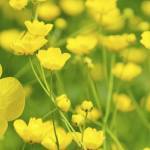Four Types of Horse Pasture Weeds Worthy of Worry

Regardless of how much high-quality pasture you have, some weeds are inevitable. While some of those weeds may be innocuous, others are terribly noxious and could be directly toxic to the horse. Here are four different ways that weeds can wreak havoc on horse health:
1. Weeds that cause physical damage. Some weeds, like foxtail, have miniature barbs on the seeds and stems. When grasped by the horse, they cause trauma to the mouth, tongue, and gums, and may cause damage further in the gastrointestinal tract. The barbs can also cause physical injury to the skin when the horse makes contact.
2. Toxin-containing weeds. There are many weeds that produce a variety of toxins (poisons), affecting horses in many different ways. The buttercup, a widespread weed throughout North America, contains a toxin that causes blistering when the plant is chewed or crushed. Another example is wild cherry, which produces hydrogen cyanide. Although horses prefer not to consume these types of weeds, overgrazed pastures often force hungry horses to find alternate sources of food, highlighting the importance of rotating pastures and not overstocking.
3. Weeds harboring microorganisms. A classic example is fescue toxicity. In this case, the fescue itself is not problematic. In some pastures, however, the fescue is infected with a microscopic fungus that lives between the cells of the fescue. That fungus, Acremonimum coenophialum, produces a toxic called ergovaline that negatively impacts mare reproduction (causing prolonged gestation, retained placenta, lack of or reduced milk production, etc.). Most other horses are able to graze on endophyte-infested tall fescue without problem, but pregnant mares should not have access to this forage.
4. Weeds choking out forages. Aggressive weeds such as thistle can quickly take over a pasture. Without controlling weeds that grow and spread rapidly, the pasture forages originally planted for horses to graze are unable to grow. This means the nutritional benefit of being on pasture is severely limited in weed-infested pastures. Certain forages, like fescue (endophyte-free, preferably), has a deep root system and is better able to compete with weeds than orchardgrass, for example.
“The exact kinds of weeds that horse owners need to be leery of vary based on geography, the age of the pasture, number of horses grazing a field, and other factors. One of the best ways to ensure the safety of your fields is to seek the assistance of your local cooperative extension specialist,” says Kathleen Crandell, Ph.D., nutritionist at Kentucky Equine Research.
For more information on poisonous plants see Check Horse Pastures for Poison Plants, Check Horse Pastures for Forbidden Fruits, and Watch Out for Toxic Plants in Hays, Pastures.








